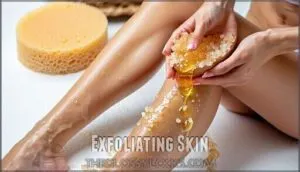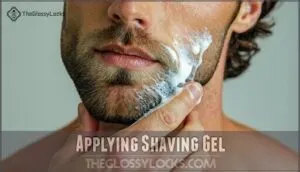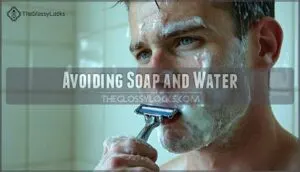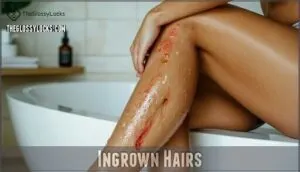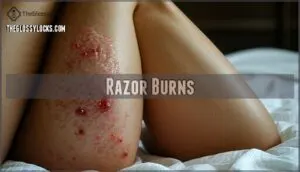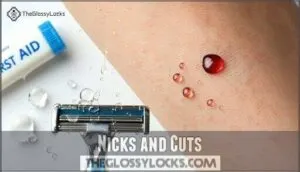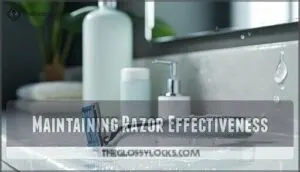This site is supported by our readers. We may earn a commission, at no cost to you, if you purchase through links.
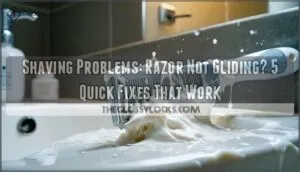
First, check if your blade’s dull—old blades drag and pull rather than cut cleanly. Second, you might need more lubrication; insufficient shaving cream creates friction that stops smooth movement.
Third, examine your technique—pressing too hard or shaving against the grain causes resistance. Fourth, hair and soap buildup in your razor creates drag, so rinse frequently during shaving.
Table Of Contents
- Key Takeaways
- Razor Not Gliding Smoothly
- Shaving Preparation Tips
- Common Shaving Problems
- Maintaining Razor Effectiveness
- Achieving Smooth Shave
- Frequently Asked Questions (FAQs)
- Why is my razor not working shaving?
- Why are shaving razors locked up?
- Why is my razor not getting a close shave?
- Can hard water affect razor gliding performance?
- Should I replace razors more frequently in humid climates?
- Does shaving direction matter for sensitive skin types?
- How does water temperature impact shaving cream effectiveness?
- Conclusion
Key Takeaways
- Replace dull blades immediately – You’ll know it’s time when your razor tugs and pulls instead of cutting cleanly through hair after 5-7 shaves
- Use proper lubrication and prep – You need generous shaving cream or gel on warm, wet skin to create the slippery barrier that prevents dragging and friction
- Fix your technique – You’re pressing too hard if your razor isn’t gliding; let the blade’s weight do the work and shave with the grain using light strokes
- Keep your razor clean – You must rinse frequently during shaving and after each use to prevent hair and product buildup that creates drag between the blades
Razor Not Gliding Smoothly
When your razor feels like it’s dragging across your skin instead of gliding smoothly, you’re likely dealing with a dull blade or insufficient lubrication.
This common problem can turn your daily routine into an uncomfortable struggle, but it’s easily fixable with the right approach.
Dull Razor Blades
After five shaves, your razor blades start showing clear sharpness indicators like tugging and pulling.
Dull razor blades create microscopic damage from repeated use, reducing blade sharpness substantially.
Replace your razor replacement every week for daily shavers, as proper cleaning methods and storage impacts can extend blade lifespan, but replacement frequency remains vital for smooth gliding.
Visible rust indicates that you need immediate blade replacement.
Insufficient Shaving Cream
Without enough shaving cream or gel, your razor drags against dry skin instead of gliding smoothly. Skimping on shaving preparation creates friction that leads to tugging and irritation.
Insufficient lubrication turns your daily shave into a battle against stubborn, dragging blades.
Apply a generous layer of quality shaving cream to create proper lather. Let it sit for 2-3 minutes to soften hair.
Consider cream alternatives like moisturizing gels for sensitive skin. Many brands offer specialized shaving products for a more comfortable shave with less irritation.
Incorrect Shaving Technique
Proper shaving technique prevents razor drag and irritation. Your blade angle, pressure, and stroke direction matter more than you think.
Master your blade angle, pressure, and direction—these fundamentals transform dragging razors into effortless glides.
A key part of this is proper skin preparation before shaving.
- Blade Angle: Hold your razor at 30 degrees against skin – too flat scrapes, too steep misses hairs
- Pass Pressure: Let the razor’s weight do the work – excessive force causes nicks and shaving irritation
- Skin Stretching: Pull skin taut in curved areas for smoother glide and fewer shaving mistakes
Clogged Razor
Hair buildup and product residue turn your razor into a sluggish mess.
When shaving cream, dead skin cells, and hair clog between blades, razor rinsing becomes essential. Rinse frequently during each shave to prevent clogging.
Clogging prevention starts with proper razor hygiene and consistent rinsing frequency throughout your shave.
| Problem | Cause | Solution |
|---|---|---|
| Razor clogging | Hair buildup between blades | Rinse razor after every stroke |
| Product buildup | Shaving cream residue | Use warm water for thorough cleaning |
| Poor blade design | Multi-blade razors trap debris | Switch to single or double-blade razor |
Shaving Preparation Tips
Proper preparation makes the difference between a smooth shave and a frustrating experience with tugging and irritation.
You’ll want to focus on four key steps that create the ideal conditions for your razor to glide effortlessly across your skin, which is crucial for a smooth shave.
Exfoliating Skin
Exfoliation removes dead skin cells that trap your razor and cause dragging.
Use a loofah or body scrub 1-2 times weekly to prevent this buildup. Gentle exfoliation benefits include smoother razor glide and fewer ingrown hairs.
Choose scrub types based on your skin sensitivity—sugar scrubs work well for sensitive skin. Regular skin exfoliation creates the perfect canvas for shaving.
Using Warm Water
Warm water opens your pores and softens hair before shaving, making your razor glide effortlessly.
Take a warm shower or apply a damp washcloth for 2-3 minutes.
This hydration benefit reduces tugging and prevents razor problems, creating ideal conditions for smooth shaving, as the temperature sensitivity of your skin responds well to moderate warmth.
Applying Shaving Gel
After warm water preparation, apply shaving gel to create ideal razor glide. Quality shaving gel softens hair and protects your skin from blade friction. Finding the best shaving products guarantees a comfortable shave.
Follow these application steps:
- Layer Thickness: Apply thin, even coat covering all areas you’ll shave
- Application Time: Let gel sit 2-3 minutes for maximum hair softening
- Gel Ingredients: Choose alcohol-free formulas for sensitive skin protection
- Gel Alternatives: Consider shaving cream if you prefer richer texture
Avoiding Soap and Water
Your soap isn’t doing your razor any favors. Regular soap strips natural oils, causing skin dryness and poor razor glide.
Hair catching becomes common when soap creates drag instead of smooth lubrication. This leads to razor burn and irritation causes you can avoid.
Skip soap and water combinations. Instead, choose shaving gel or alternative cleansers designed for shaving and skin cleansing protection.
Common Shaving Problems
When your razor doesn’t glide smoothly, you’re likely dealing with one of four common shaving problems that can turn your routine into a frustrating experience.
These issues—ingrown hairs, razor burns, skin irritation, and nicks and cuts—often stem from the same underlying causes that prevent your razor from moving effortlessly across your skin, which can be attributed to razor burns and other factors.
Ingrown Hairs
Countless razor bumps form when hair curls back into your skin after shaving.
Preventing ingrowns starts with proper exfoliation and shaving with the grain. Treating ingrowns requires gentle care—avoid picking at bumps.
Ingrown causes include dull razors and dry shaving. Ingrown symptoms show as red, painful bumps.
Ingrown location varies but commonly affects legs, face, and bikini areas where shaving problems create skin irritation. To soothe irritation, consider using corticosteroids and hydrocortisone.
Razor Burns
After shaving, razor burn appears as red, inflamed patches that sting and feel tender to the touch. This common condition occurs when your razor drags across skin instead of gliding smoothly, causing micro-cuts and inflammation.
- Red, bumpy patches that feel hot and tender
- Stinging sensation when you apply aftershave or moisturizer
- Tight, dry skin that may peel or flake
- Swollen hair follicles that create a sandpaper-like texture
Burn severity varies from mild redness to painful welts. Post-shave care becomes essential – rinse with cold water, then apply a gentle moisturizer to calm inflammation. Avoid clothing friction by wearing loose-fitting garments until healing occurs, which helps prevent further irritation and promotes smoother skin, making gentle moisturizer a key part of the healing process.
Skin Irritation
Beyond razor burns lies another common concern.
Skin irritation manifests as post-shave redness, itchiness, and bumps that make you want to scratch constantly.
Your sensitive skin reacts to improper technique, dull blades, or skipping moisturizer.
Prevention beats treatment every time.
| Irritation Type | Cause | Prevention |
|---|---|---|
| Post-shave redness | Hot water, pressure | Use lukewarm water, light strokes |
| Itchiness relief needed | Dry skin, harsh products | Apply fragrance-free moisturizer immediately |
| Bump prevention required | Against-grain shaving | Follow hair growth direction |
| Sensitive skin reactions | Chemical irritants | Choose hypoallergenic shaving cream |
| Shaving rash development | Poor razor maintenance | Replace blades every 5-7 shaves |
Nicks and Cuts
Accidental shaving nicks and cuts happen when you rush or use excessive pressure.
A sharp razor requires minimal force—dull blades need more pressure, increasing injury risk.
Control skin tension by stretching taut areas gently.
For wound care, rinse cuts immediately with cold water and apply pressure with clean tissue.
Use styptic pencils or alum blocks for bleeding control.
Proper blade sharpness and gentle technique prevent most shaving safety issues.
Maintaining Razor Effectiveness
Your razor’s performance depends entirely on proper maintenance and care.
Replace blades every 5-7 shaves, rinse thoroughly after each use, and store in a dry place to prevent rust and keep that smooth glide you’re after.
Regular Blade Replacement
Your razor blade’s lifespan directly impacts shaving performance. Most blades deliver peak sharpness for 5-10 shaves before becoming dull.
Replace blades when you notice increased pressure requirements, tugging sensations, or uneven cutting. Dull blades compromise razor hygiene and increase irritation risks.
Track your replacement frequency to maintain consistent blade sharpness. Consider purchasing blade replacements to guarantee you always have a sharp blade ready.
Regular razor blade replacement frequency prevents costly skin damage while guaranteeing smooth results.
Cleaning and Drying Razor
After each shave, your razor needs proper cleaning and drying to maintain peak performance.
Hair clippings and product buildup create the perfect breeding ground for bacteria, while moisture accelerates blade corrosion and rust formation.
- Rinsing frequency: Rinse blade under warm water after every few strokes during shaving
- Drying methods: Pat razor dry with clean towel and air-dry completely before storing
- Product buildup: Use soft brush to remove stubborn shaving cream residue from blade gaps
- Disinfecting razors: Weekly alcohol wipe-down prevents bacteria buildup and maintains shaving hygiene
Storing Razor Properly
Proper razor storage keeps your blade sharp longer and prevents bacteria buildup.
Store your razor upright in ventilated areas like a medicine cabinet or countertop stand. This dry storage position allows air circulation around the blade, preventing moisture retention that causes blade corrosion.
Avoid humid bathroom drawers or enclosed containers where bacteria thrive, compromising your shaving hygiene.
Avoiding Rust and Corrosion
Rust forms when razors stay wet after use.
Dry your razor thoroughly with a towel, then store it upright in a cool, dry location away from your shower.
Apply light mineral oil to blade material for extra protection.
Clean weekly with diluted vinegar to remove mineral deposits from hard water quality, extending blade longevity through proper razor maintenance and rust prevention techniques.
High-carbon steel razors benefit from protective oil coatings for extra durability and to prevent rust.
Achieving Smooth Shave
When your razor fights against your skin instead of gliding smoothly, you’re dealing with a common shaving problem that has straightforward solutions.
The key to achieving that effortless, smooth shave lies in proper preparation, sharp blades, and the right post-shave care routine.
Shaving With The Grain
Your razor struggles less when you follow your hair growth direction.
Shaving with the grain reduces irritation and prevents tugging that makes your razor feel stuck.
Here’s how to master grain mapping for smoother first pass shaving:
- Map your hair patterns – Run your hand across dry skin to feel which way hair grows
- Start with short strokes – Use gentle, controlled movements following the natural direction
- Rinse frequently – Clear hair buildup that creates drag during technique refinement
- Reapply cream – Add more product if your razor starts catching mid-shave
Using Sharp Razor Blades
A sharp blade sharpness makes the difference between smooth gliding and painful tugging.
Replace your razor blade after five to seven shaves to maintain ideal razor angle and prevent razor burn.
Dull blades require extra pressure, increasing skin sensitivity and irritation.
Fresh blades slice through hair cleanly, reducing friction and making shaving techniques more effective.
To extend lifespan, consider proper razor storage for smooth shaves.
Applying Moisturizer
Hydration becomes your skin’s best friend after shaving removes its natural protective barrier.
Apply moisturizer immediately after patting skin dry to lock in moisture and prevent irritation.
Choose fragrance-free formulas with ingredients like aloe vera or ceramides for sensitive skin.
Non-comedogenic moisturizers won’t clog pores, while products with SPF provide essential sun protection for freshly shaved areas.
Avoiding Tight Clothing
Tight clothing after shaving creates unnecessary friction against freshly exposed skin, increasing your risk of razor burn and ingrown hairs.
Choose loose garments made from breathable materials like cotton to allow proper air circulation.
This simple post-shave fabric choice provides effective irritation prevention while your skin recovers from the shaving process.
Frequently Asked Questions (FAQs)
Why is my razor not working shaving?
A dull blade versus sharp steel makes all the difference.
Your razor’s struggling because it’s either dull, clogged with hair, lacks proper lubrication, or you’re pressing too hard.
Replace the blade and use shaving cream.
Why are shaving razors locked up?
Retailers lock up razors to prevent theft. These small, expensive items are frequently stolen, so stores secure them behind locked cases or require cashier assistance to access them.
Why is my razor not getting a close shave?
Like trying to cut paper with a butter knife, your razor’s lost its edge.
You’re likely using a dull blade, skipping shaving cream, or shaving dry skin.
Replace your razor every 5-7 shaves and always prep with warm water and quality shaving gel first.
Can hard water affect razor gliding performance?
Yes, hard water can definitely affect your razor’s gliding performance.
Mineral deposits from calcium and magnesium build up on razor blades, creating rough surfaces that drag against skin and clog between blade edges, which can be considered a complete issue related to the razor’s performance.
Should I replace razors more frequently in humid climates?
Wondering if humidity’s affecting your shave?
Yes, replace razors more frequently in humid climates.
Moisture accelerates blade corrosion and dulling, reducing performance.
Store your razor in a dry place between uses.
Does shaving direction matter for sensitive skin types?
Shaving direction absolutely matters for sensitive skin.
Always shave with the grain first to minimize irritation and razor burn.
Going against the grain increases ingrown hairs and inflammation for delicate skin types, which is why shaving with the grain is crucial.
How does water temperature impact shaving cream effectiveness?
Warm water opens your pores and softens hair, allowing shaving cream to penetrate better and create a protective barrier. Cold water constricts pores, reducing cream effectiveness and increasing irritation risk.
Conclusion
Remember when your car runs smoothly until it doesn’t? Your razor works the same way.
Addressing shaving problems when your razor isn’t gliding requires checking blade sharpness, adding proper lubrication, adjusting technique, and clearing buildup.
Replace dull blades immediately, use quality shaving cream, shave with the grain using light pressure, and rinse frequently.
These simple adjustments transform a frustrating shave into a smooth, comfortable experience that protects your skin, and result in a more comfortable shave.
- https://knifesteelnerds.com/2021/01/11/what-causes-razor-blades-to-dull/
- https://www.goodrx.com/health-topic/dermatology/how-often-change-razor-blade
- https://www.delawarepublic.org/2020-08-06/cutting-edge-research-shows-how-hair-dulls-razor-blades
- https://www.razoremporium.com/blog4-telltale-signs-your-wet-shaving-razor-is-becoming-dull
- https://www.manscaped.com/blogs/grooming/why-your-electric-razor-isn-cutting-well-troubleshooting-hacks

